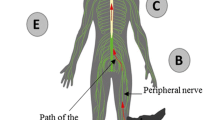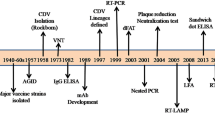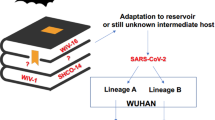Abstract
Saliva and blood were collected from two patients who had not received post exposure prophylaxis in the cities of Wenzhou and Xinning respectively. Both patients were confirmed as positive for rabies by detection of rabies virus specific nucleoprotein antibodies in the sera by Western Blot. However, rabies virus specific RNA was only identified in the saliva collected from the patient in Wenzhou. Furthermore, the isolate Zhejiang Wz0 (H) was obtained by inoculating one-day-old suckling mice. Both nucleoprotein (N) and glycoprotein (G) genes from the isolate were amplified by RT-PCR and sequenced. Phylogenetic analysis indicated that the isolate belonged to classic rabies virus, and shared a higher homology with the street viruses from dogs in the main endemic areas in China and the street virus from dogs in Indonesia than with other known strains. Further comparison of the deduced amino acid sequences between the isolate and the vaccine strains used in China showed that the virus had a higher level of homology with the vaccine strain CTN than with the other vaccine strains (3aG, PV, PM and ERA). In particular, amino acid residues substitutions located in antigenic site III in the G protein, which could react with the neutralizing antibodies, were observed. These results suggested that the virus belonged to the classic rabies virus, and both N and G genes diverged from the current vaccine strains used in China at either the nucleotide or the amino acid level.
Similar content being viewed by others
References
Arai Y T, Kuzmin I V, Kameoka Y, et al. 2003. New lyssavirus genotype from the Lesser Mouse-eared Bat (Myotis blythi), Kyrghyzstan. Emerg Infect Dis, 9(3): 333–337.
Badrane H, Bahloul C, Perrin P, et al. 2001. Evidence of two Lyssavirus phylogroups with distinct pathogenicity and immunogenicity. J Virol, 75(7): 3268–3276.
Benmansour A, Leblois H, Coulon P, et al. 1991. Antigen city of rabies virus glycoprotein. J Virol, 65(8): 4198–4203.
Bourhy H, Kissi B, Tordo N. 1993. Molecular diversity of the Lyssavirus genus. Virology, 194(1): 70–81.
Bourhy H, Kissi B, Audry L, et al. 1999. Ecology and evolution of rabies virus in Europe. J Gen Virol, 80(Pt 10): 2545–2557.
Cisterna D, Bonaventura R, Caillou S, et al. 2005. Antigenic and molecular characterization of rabies virus in Argentina. Virus Res, 109(2): 139–147.
David D, Yakobson B, Smith J S, et al. 2000. Molecular epidemiology of rabies virus isolates from Israel and other middle-and Near-Eastern countries. J Clin Microbiol, 38(2): 755–762.
Dietzschold B, Rupprecht C E, Fu Z F, et al. 1996. Rhabdoviruses. Fields Virology, Philadelphia: Lippincott-Raven Press, p1245–p1277.
Dietzschold B, Schnell M, Koprowski H. 2005. Pathogenesis of rabies. Curr Top Microbiol Immunol, 292: 45–56.
Favi M, Nina A, Yung V, et al. 2003. Characterization of rabies virus isolates in Bolivia. Virus Res, 97(2): 135–140.
Hyun B H, Lee K K, Kim I J, et al. 2005. Molecular epidemiology of rabies virus isolates from South Korea. Virus Res, 114(1–2): 113–125.
Ito M, Itou T, Sakai T, et al. 2001. Detection of rabies virus RNA isolated from several species of animals in Brazil by RT-PCR. J Vet Med Sci, 63(12):1309–1313.
Mebatsion T. 2001. Extensive attenuation of rabies virus by simultaneously modifying the dynein light chain binding site in the P Protein and replacing Arg333 in the G protein. J Virol, 75(23): 11496–11502.
Perrin P, Thibodeau L, Sureau P. 1985. Rabies immunosome (subunit vaccine) structure and immunogenicity. Pre-and post-exposure protection studies. Vaccine, 3(3): 325–332.
Sato G, Itou T, Shoji Y, et al. 2004. Genetic and phylogenetic analysis of glycoprotein of rabies virus isolated from several species in Brazil. J Vet Med Sci, 66(7): 747–753.
Smith J S, Orciari L A, Yager P A, et al. 1992. Epidemiologic and historical relationships among 87 rabies virus isolates as determined by limited sequence analysis. J Infect Dis, 166(2): 296–307.
Tang Q, Orciari L A, Rupprechti C E, et al. 2000. Sequencing and position analysis of the glycoprotein gene of four Chinese rabies viruses. Virologica Sinica, 15(1): 22–33. (in Chinese)
Tang X C, Luo M, Zhang S Y, et al. 2005. Pivotal role of dogs in rabies transmission, China. Emerg Infect Dis, 11(12): 1970–1972.
Tordo N, Kouknetzoff A. 1993. The rabies virus genome: an overview. Onderstepoort J Vet Res, 60(4): 263–269.
Willoughby R J, Tieves K S, Hoffman G M, et al. 2005. Survival after treatment of rabies with induction of coma. N Engl J Med, 352(24): 2508–2514.
World Health Organization. 2005. WHO Expert Committee on Rabies, Geneva: World Health Organ Tech Rep Ser 931, P12.
Wunner W H, Larson J K, Dietzschold B, et al. 1988. The molecular biology of rabies viruses. Rev Infect Dis, 10,(Suppl 4): S771–784.
Xu G L, Li K, Wu J, et al. 2002. Sequence analysis of N gene among 19 rabies virus street isolates from China. Chin J Epidemiol, 18(1): 48–51. (in Chinese)
Yu Y X, 2001. Rabies and rabies vaccine, Beijing: Chinese Medicine Technology Press, P10–20 (in Chinese).
Zhang Y Z, Xiong C L, Feng Z J, et al. 2004. The survey of 21 cases of human rabies in Anlong County in Guizhou province. Chin J Epidemiol, 25(10): 870–872. (in Chinese)
Zhang Y Z, Xiong C L, Xiao D L, et al. 2005. Human rabies in China. Emerg Infect Dis, 11(12): 1983–1984.
Zhang Y Z, Xiong C L, Zou Y, et al. 2006. An epidemiological study on Rabies in Wugang and Dongkou counties, Hunan. Chin J Epidemiol, 27(7): 583–588. (in Chinese)
Zhang Y Z, Xiong C L, Zou Y, et al. 2006. An epidemiological study of rabies in Anlong county of Guizhou province. Virologica Sinica, 21(4): 394–400. (in Chinese)
Zhang Y Z, Xiong C L, Zou Y, et al. 2006. Molecular characterization of rabies virus isolates in China during 2004. Virus Res, 121(2): 179–188.
Author information
Authors and Affiliations
Corresponding author
Additional information
Foundation items: The project was supported by the Grants (2003BA712A08-02 and 2004BA718B03) from the Chinese Ministry of Science and Technology.
Rights and permissions
About this article
Cite this article
Yao, Wr., Pan, Gq., Xiong, Cl. et al. Detection and genetic characterization of rabies virus from human patients. Virol. Sin. 22, 307–315 (2007). https://doi.org/10.1007/s12250-007-0007-2
Received:
Accepted:
Published:
Issue Date:
DOI: https://doi.org/10.1007/s12250-007-0007-2




